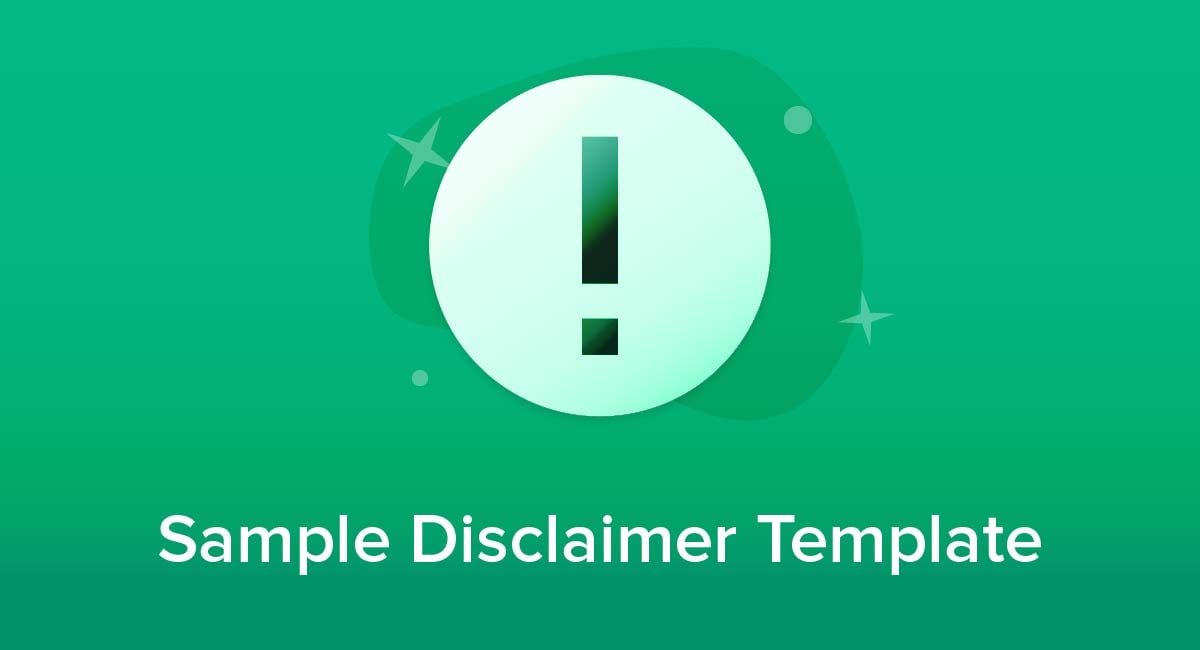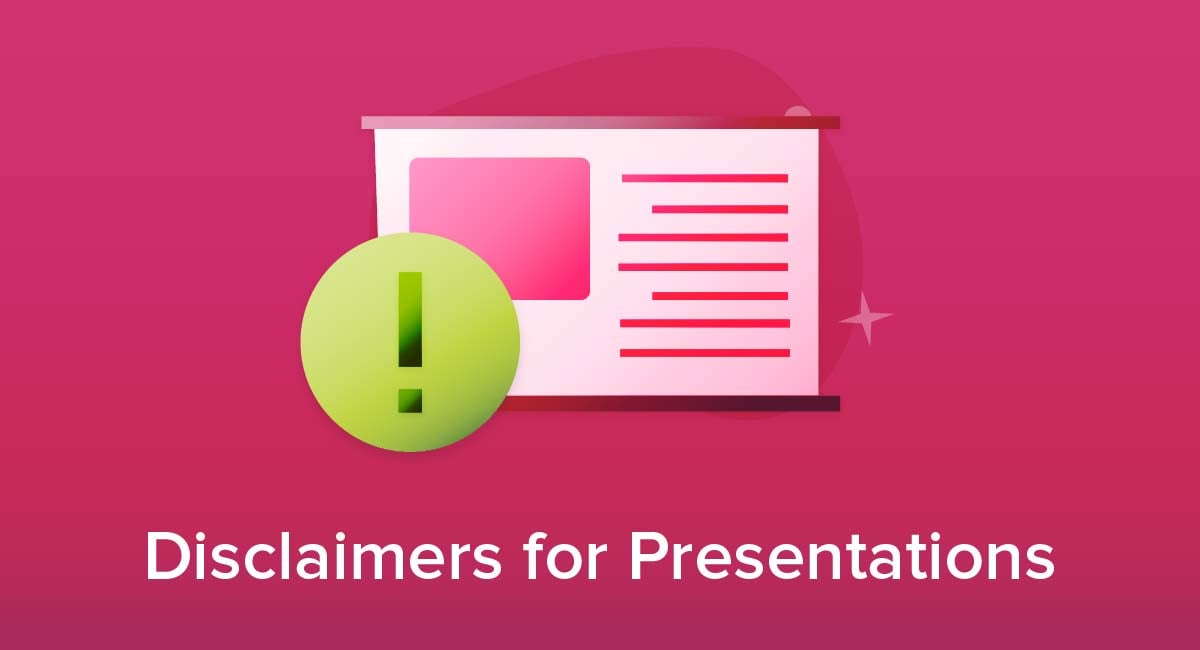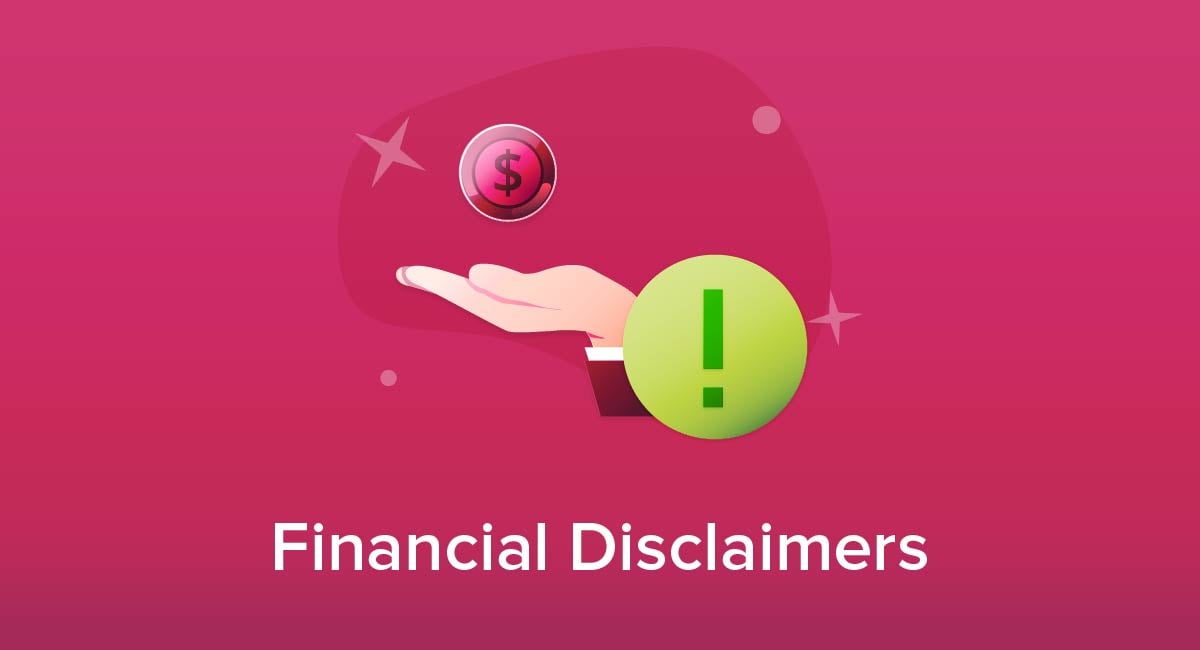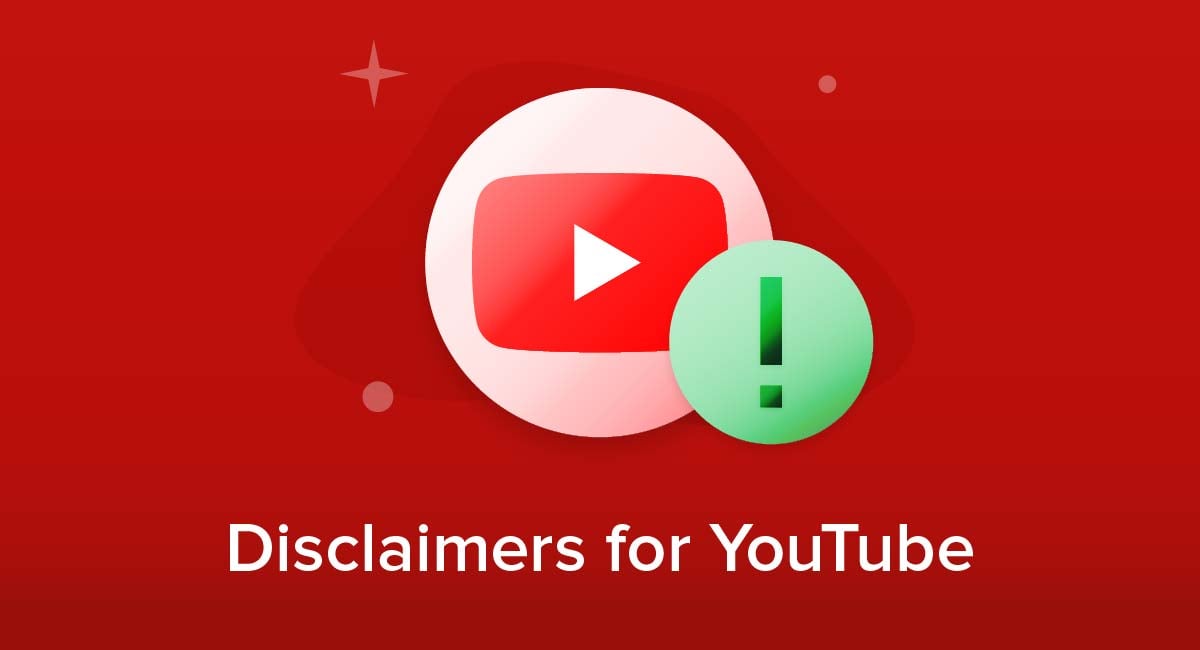
When you post content to YouTube, you may create legal obligations or raise legal questions. Using clear disclaimers can limit these obligations and help answer these questions. This can reduce the chances of you facing legal problems.
This article will show examples and purposes of some of the most common YouTube disclaimers, explain when it makes sense to use them, and detail the best ways to display them on your YouTube channel.
Our Free Disclaimer Generator is designed to help you comply with the requirements of various affiliate programs, such as Amazon Associates. It also includes various disclaimers like medical disclaimer, fitness disclaimer, website disclaimer and so on.
Just follow these few simple steps and generate a Free Disclaimer for your site or your app:
- Start by choosing the "Free Disclaimer Generator" on our site.
-
Then select where your Disclaimer will be used on:
-
Follow with adding your website/app information:
-
Enter the country and click on the "Next Step" button:
-
Continue with building your Disclaimer and answer on questions about your business from our wizard:
-
Now just enter your email address where you'd like your Disclaimer sent and click on the "Generate" button.
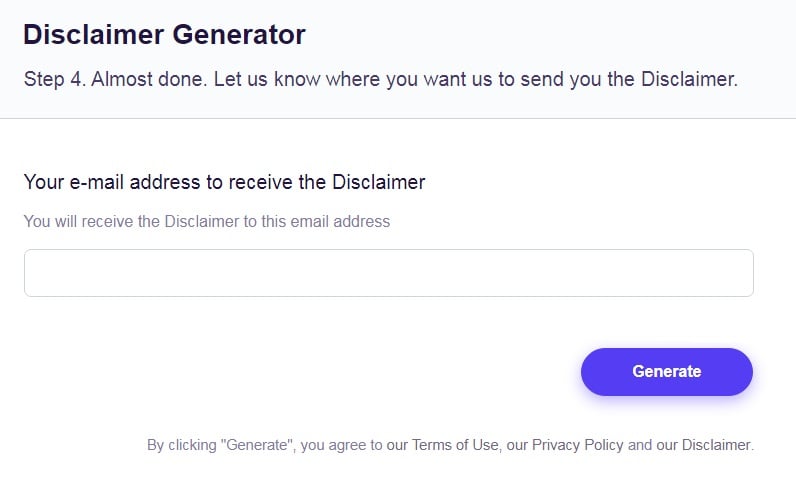
You're done! You can copy and paste your Disclaimer code into your website/app, or link to your hosted Disclaimer page.
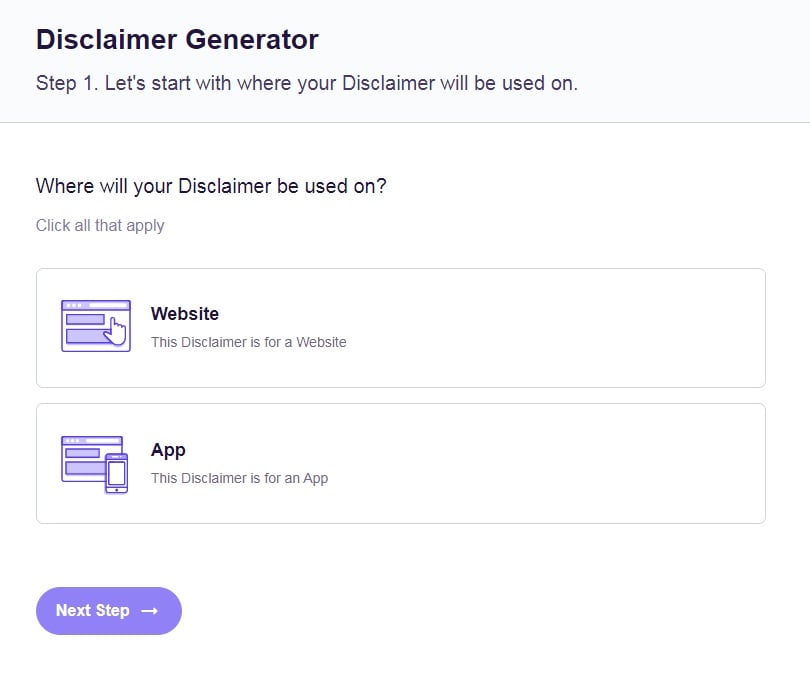
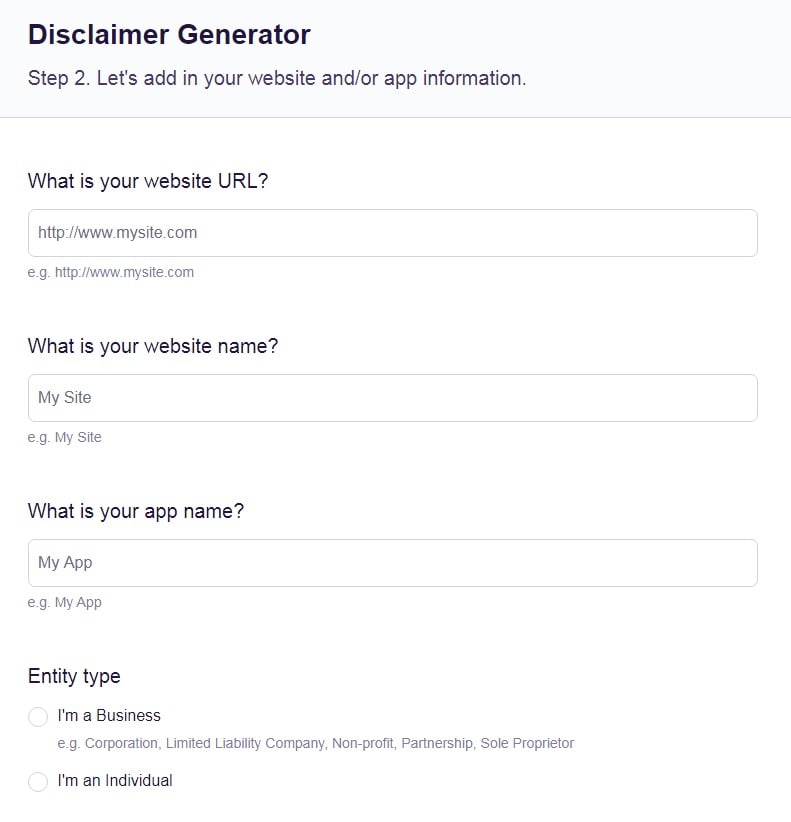
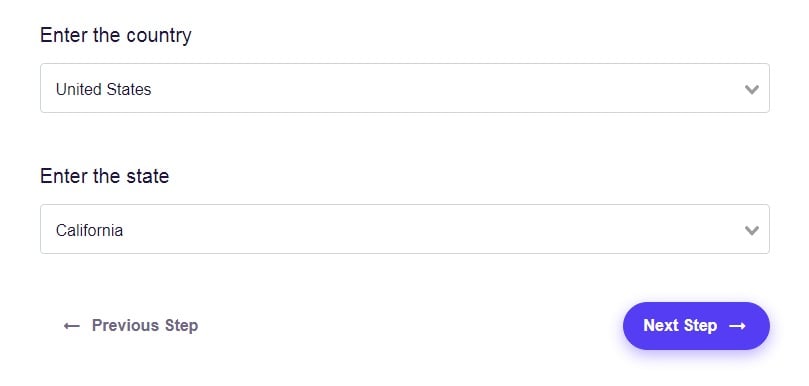
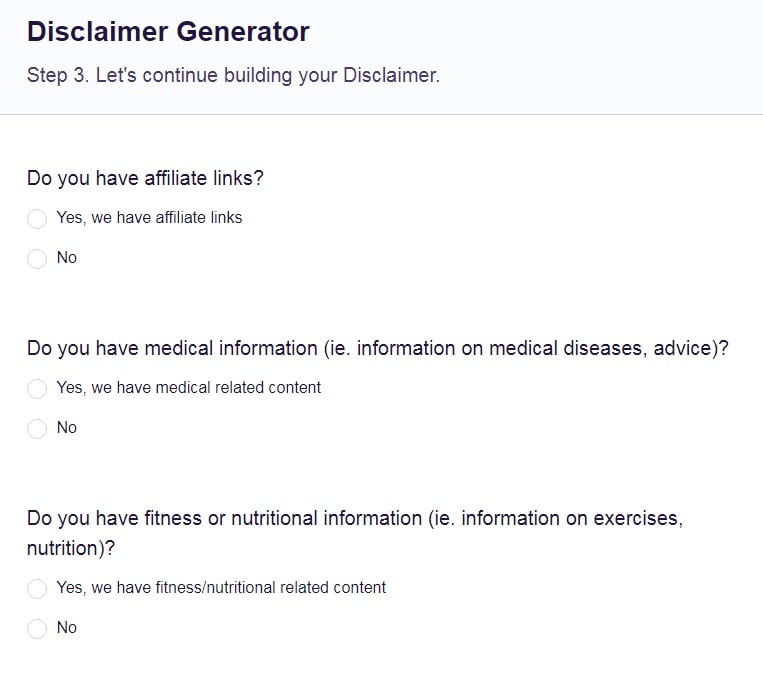
- 1. What are Disclaimers?
- 2. Does YouTube Require Disclaimers?
- 3. Common YouTube Disclaimers
- 3.1. Affiliate Links Disclaimer
- 3.2. Views Expressed Disclaimer
- 3.3. Fair Use Disclaimer
- 3.4. Liability Disclaimers
- 4. How to Display Disclaimers for YouTube
- 4.1. In the Video
- 4.2. In the Video Title or Description
- 4.3. In the Channel's "About" Section
- 4.4. YouTube Automated Disclaimer
- 5. Summary
What are Disclaimers?
A disclaimer is a statement designed to limit your legal obligations while informing another party of something important.
For example, a disclaimer can let people who watch your video know that you aren't offering medical advice, that you are not responsible for any damages that result after watching your video, and that you earn commission from affiliate links in the video description.
Here's an example of a disclaimer that addresses a range of topics:
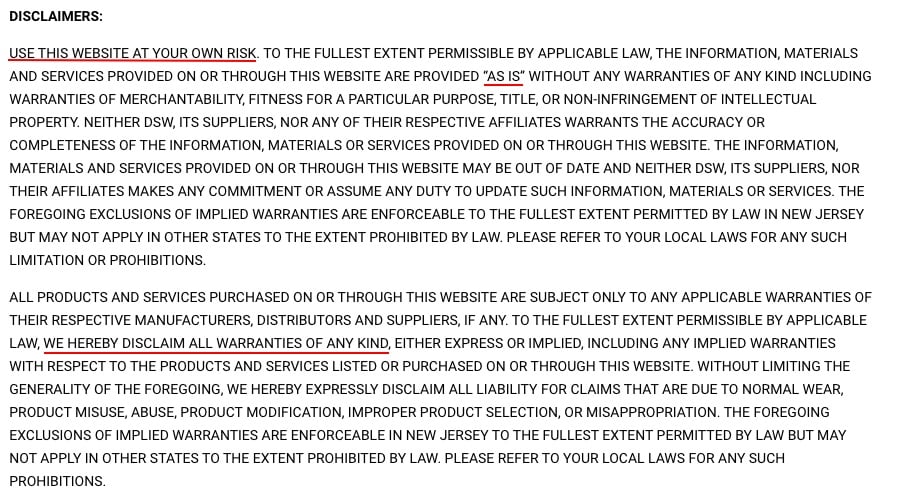
Does YouTube Require Disclaimers?

YouTube's Terms of Service states that you must comply with laws when you use its platform. Some disclaimers are legally required. Thus, YouTube in effect does require disclaimers in some situations. YouTube also has specific disclaimer requirements.
Even when not legally required, having disclaimers can help elevate your YouTube channel by helping limit your legal liability, while making your page look more professional.
YouTube's Terms of Service says:
"You may access and use the Service as made available to you, as long as you comply with this Agreement and the law."
In other words, if you are legally required to post a disclaimer on a YouTube video, and if you don't do so, you could lose access to YouTube as well as facing any other legal consequences.
The main legal requirement that affects YouTube videos is the Federal Trade Commission (FTC) advertising endorsement rules. These apply if "it's reasonably foreseeable that the post will affect U.S. consumers."
The rules say you must "disclose when you have any financial, employment, personal or family relationship with a brand."
The FTC has full guidance on the rules, but the main principle is that they apply very broadly. For example:
- The rules aren't limited to cases where you receive money. They also apply if you get something free of charge, including review copies and samples.
- The rules aren't limited to getting something from the manufacturer or retailer of the product. They also apply to affiliate links where you receive payment when somebody buys the product.
- The rules can still apply even if the person paying you or providing the goods doesn't insist you mention them.
- The rules still apply if you mention the products without giving your opinion, or if you give a negative review.
YouTube also requires you to include a disclaimer in three specific circumstances, which line up with the FTC requirements but can apply to people who don't necessarily have to comply with the FTC:
- Paid product placements: You have been paid to either create content or include content on behalf of somebody else. This usually means integrating the message into the content itself.
- Endorsements: You have been paid to create content with a message in such a way that it appears to be your own opinion.
- Sponsorship: You've been paid to promote a brand, product or message alongside a video, even if the brand or message isn't part of the content itself.
In these cases, you may be able to use YouTube's built-in disclosure feature, which we'll detail later on in this guide. Note that this feature may not be up to FTC standards.
Common YouTube Disclaimers

You may need or benefit from a YouTube disclaimer in several situations, even when YouTube itself doesn't explicitly require one. We'll break down these disclaimers one-by-one in the rest of this guide:
- An affiliate links disclaimer reveals you may receive commission for purchases made by people who follow the link.
- A views expressed disclaimer emphasizes that you are posting in a personal capacity.
- A fair use disclaimer covers cases when you post content that includes somebody else's intellectual property.
- A liability disclaimer helps protect you when you give advice or instructions.
Affiliate Links Disclaimer
If you use affiliate links in your YouTube content, you will need to include an affiliate link disclaimer that discloses that you'll receive a benefit if the link is used.
Affiliate links are where you link to a product or service (usually an online store listing page) using special code that identifies you as the source of the link. In return, you receive commission if the person who follows the link buys the product.
Some YouTube creators include affiliate links in the video description, for example linking to products which they have used or featured in the video. An affiliate link disclaimer tells users that you will receive commission if they follow the link and make a purchase.
Although YouTube doesn't directly require an affiliate link disclaimer, this could be covered by its rule that you must comply with applicable laws:
The FTC requires that you disclose when you are using affiliate links.
In addition, when you sign up for many affiliate link programs, you'll have to agree to terms that will likely require you to disclose you are using affiliate links.
Adz Ventures uses Amazon's required wording for affiliate links. This wording is also suitable for other affiliate link programs that don't have their own required wording:

Views Expressed Disclaimer
A views expressed disclaimer makes clear that the views expressed in a video are the personal views of the individual and not necessarily of anyone else or an organization.
This might seem obvious, but without such a disclaimer, you risk confusion in several situations:
- You or somebody featured in the video is an employee but is not speaking on their employer's behalf.
- You or somebody featured in the video is a spokesperson, representative or other public figure associated with a business, organization or group, but is not speaking on their behalf in this case.
- Somebody featured in the video says something which you (the video creator) don't necessarily personally agree with.
A views expressed disclaimer can reduce or remove the risk of this confusion. It can be as simple as saying something along the lines of "the views expressed in this video are those of the speaker only and do not necessarily reflect those of anyone else."
Alternatively you could give specific examples of a person or organization, such as "the views expressed do not necessarily reflect those of Fred Smith" or "does not speak on behalf of the Ugandan Cheese Society."
This disclaimer in a video by PaigeY makes clear she is speaking in a purely personal capacity:
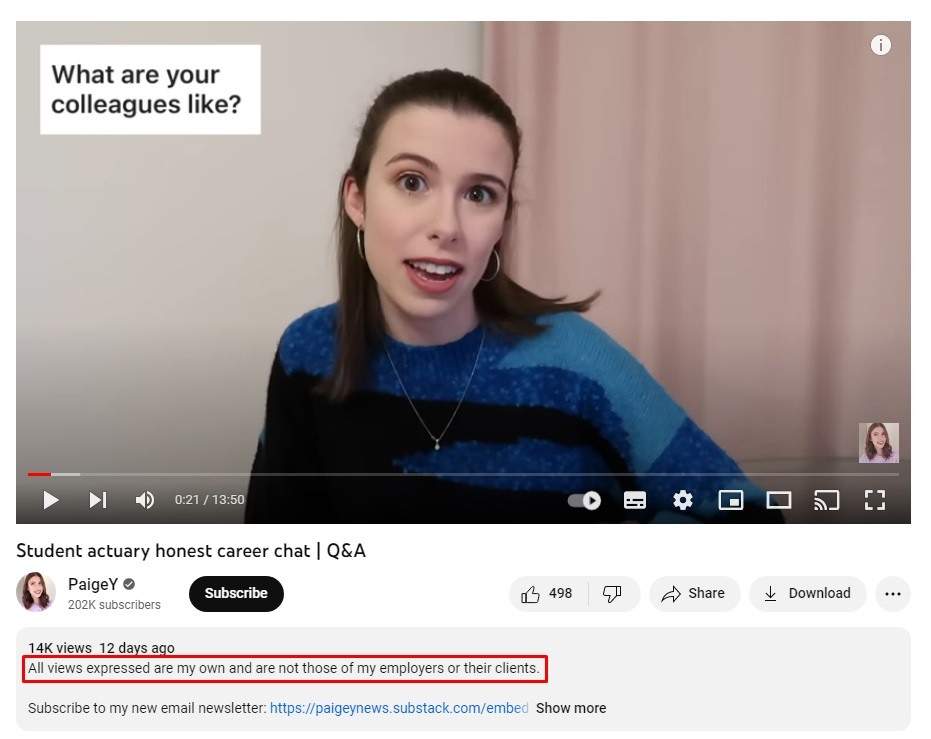
Fair Use Disclaimer
A fair use disclaimer lets the world know that you are using copyrighted material legally. When you produce a YouTube video that includes third-party content, you need to consider the copyright implications. This can include:
- Using clips of somebody else's video content
- Using somebody else's still image
- Using audio such as a song or a clip from a TV show or movie
In principle, such content is covered by copyright and it's against the law to use it without the copyright holder's permission. However, most jurisdictions have exemptions for "fair use."
The conditions for "fair use" can vary and aren't always completely open-and-shut. The law in the United States says a court must take four factors into account when deciding if something is fair use:
- How and why you are using the material (for example, whether you are trying to make a profit)
- The nature of the copyrighted material (for example, fair use could apply more to a political speech than to a pop song)
- How much of the copyrighted material you use (for example, whether it's a brief extract)
- Whether your use of the copyrighted material affects the market value of the original material
A fair use disclaimer makes clear that you believe your use of the copyrighted material is lawful because it comes under the fair use exemption. The disclaimer doesn't make your use of the material lawful in itself. Instead:
- It shows you are acting in good faith
- It may reduce the risk of the copyright holder pursuing the case
- It makes clear you are not encouraging anyone else to violate the copyright
- YouTube may be more likely to find in your favor if somebody files a copyright takedown request on your video
The main points to cover in a fair use disclaimer are:
- Acknowledge the original material is copyrighted
- Explain you are relying on the fair use exemption
- Cite the relevant section of the applicable law. (In the U.S., it's section 107 of the Copyright Act of 1976)
- Explain why your use of the content qualifies as fair use
Yendor61 covers these points in a fair use disclaimer for a video in which he uses the song "Cover of the Rolling Stone" for a slideshow of magazine covers:

Liability Disclaimers
A liability disclaimer makes clear you are not legally responsible for something that a viewer does (or does not do) as a result of watching your video. In particular, it makes clear you are not responsible for any harm or loss they suffer.
Exactly what liability disclaimers to use will depending on:
- The content of the video
- The potential risks of harm and damage that could result from the viewer's subsequent actions (or inactions)
Examples include:
- A statement that viewers follow any advice or instructions in the video at their own risk. This could be useful for instructional 'how to' guides.
- A statement that the video is not meant to create a professional relationship between you and the viewer.
- A statement that the video's content does not constitute professional advice. This may be particularly important if you are part of a regulated or licensed profession such as finance or law.
LegalEagle includes a disclaimer in every video covering several key points:

Once you have your disclaimer text ready, here's how you can best display it in your YouTube video, video description, channel "About" section and elsewhere.
How to Display Disclaimers for YouTube

You have several options for displaying a YouTube disclaimer. Which is most appropriate may depend on the nature of the disclaimer and you may want to use multiple methods.
In the Video
You can include a disclaimer in a video by:
- Having you or the presenter say the words
- Showing the words on screen in a graphic or caption
- Both of the above methods
The main advantage of including the disclaimer in the video itself is that you can be sure it is seen even if somebody has embedded your video on a third-party website.
You will also need to think about whether to put the disclaimer at the start, during or at the end of the video. Putting it at the start may be best if you are following a legal requirement and need to show you followed both the spirit and the letter of the law, as people may not watch until the end before taking in the content in some way that they act upon.
This disclaimer from Kara and Nate appears on screen and in the voiceover. It appears at the very start of the video:
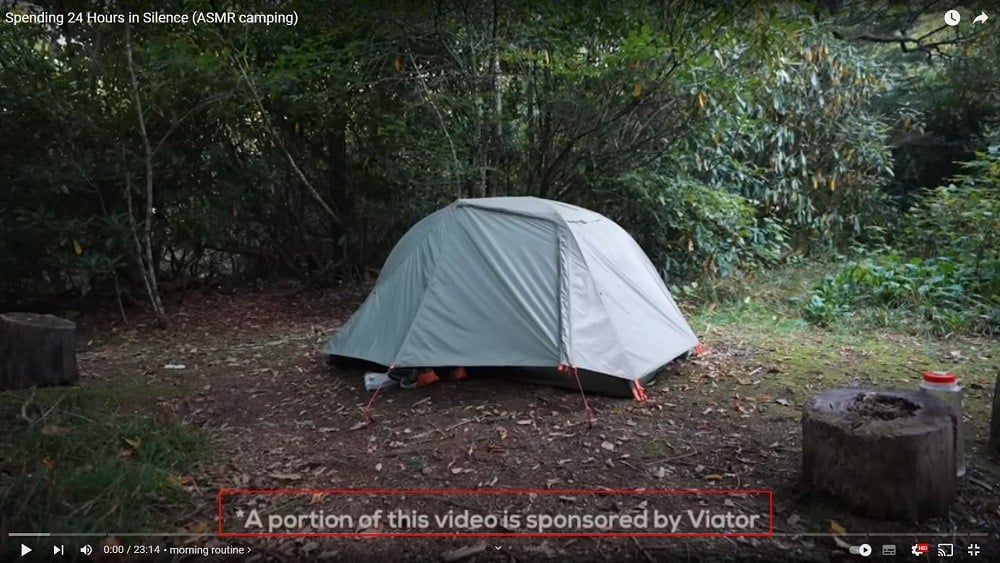
In the Video Title or Description
Putting the disclaimer in the title or description of your video (which you can insert as part of the upload process) should be enough to comply with most rules requiring disclaimers.
This video from Travel Beans includes a clear disclaimer at the start of the description:
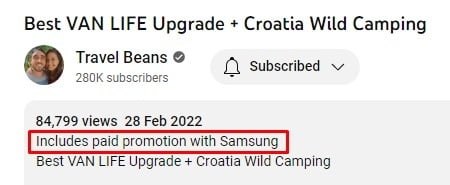
This video by TotalBiscuit Livestreams (Unofficial) includes a prominent disclaimer by stating in the video title itself that a copy was provided for review:

In the Channel's "About" Section
The 'About" section is a good place to put a disclaimer that applies to most or all of your videos. For example, if your channel health, fitness or medical topics, a health, fitness and medical disclaimer that you are not offering professional medical advice would fit well in the "About" section.
Remember that you can't be sure people will visit this page. This means including it here usually works best as well as, rather than instead of, including the disclaimer in the individual video description or the video itself.
Foot Doctor Zach includes a disclaimer on his About page:
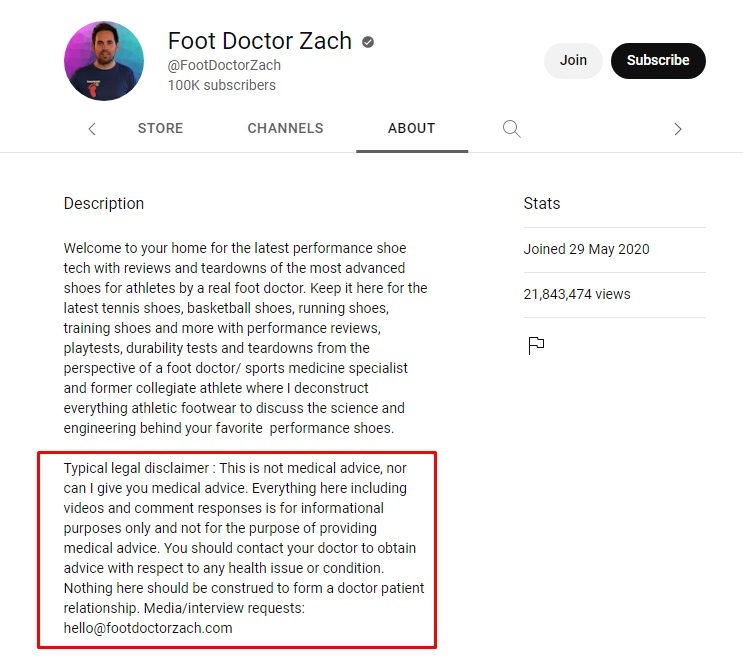
YouTube Automated Disclaimer
As previously noted, YouTube rules say you must tell it when your video involves paid product placement, endorsement, sponsorship or another commercial relationship. It gives the following instructions on how to do so:
- On a computer, sign in to YouTube Studio.
- From the left-hand section, select Content.
- Click the video that you'd like to edit.
- Select More options.
- Select the box next to 'My video contains paid promotion like a product placement, sponsorship or endorsement.'
- Select Save.
When you have ticked this box, YouTube will automatically display a relevant disclosure message over your video for the first 10 seconds. It will also:
- Remove your video from the YouTube Kids app, as videos involving commercial relationships are not allowed on that service
- Check the content of your video and, where relevant, not show ads alongside the video that might compete with the brand or product involved in your video
The automated disclosure message will satisfy YouTube's rules. Remember, though, that laws may mean you still need a more prominent, detailed or specific disclaimer.
This video by James Hoffmann includes the automated disclaimer display:
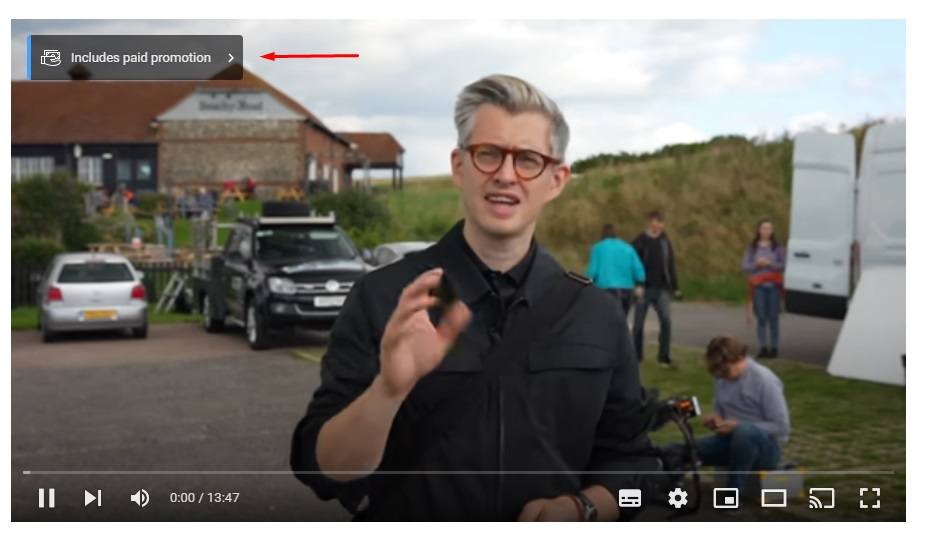
Summary
A disclaimer aims to limit your legal liability or somebody else's legal rights.
YouTube only requires disclaimers for paid and promotional content, though it also says you must follow the law. Some other disclaimers are either a legal requirement or a sensible idea.
The FTC requires a disclaimer to reveal when you have any relationship with a brand featured in your video. This includes receiving anything, including free sample or review products, even if you don't give them a positive review.
A views expressed disclaimer avoids viewers mistakenly believing somebody in the video speaks on behalf of someone else or an organization.
If you use copyrighted material in your video without permission, you may rely on a fair use exemption. If so, a disclaimer will establish and explain your assertion that the exemption applies. This may reduce the likelihood of legal actions.
If you give advice or instructions, you may need one or more liability disclaimers. These include:
- Viewers follow instructions at their own risk
- You don't have a professional relationship with the viewer
- You aren't giving professional advice
You can display a YouTube video in several ways:
- In the video (by speech or an on-screen caption)
- Through YouTube's automated disclaimer for paid content
- In the video description
- In your channel's About page
